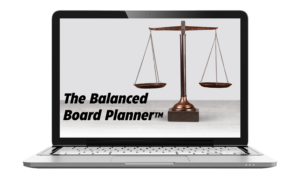In the complex landscape of organizational governance, the board of directors stands at the helm of strategic decision making. It is the role of the board of directors to set the strategic direction of the organization. Central to this responsibility is the competency of strategic thinking – a cornerstone skill that every board member should possess.
What is the board’s responsibility in the area of strategy? The following list will help you understand the board’s role in creating the vision and strategy for the organization.
The Board’s Role in Strategic Thinking
- Develop a clear vision for the future of the organization. The vision serves as the North Star, providing clarity and direction for the future. It is essential for the board to develop a vision and work with the CEO to ensure a mutual understanding. The CEO should then take that vision and work with their management team to develop strategies around that vision.
- Create and communicate a clear sense of the organization’s purpose and mission. Clearly communicating the organization’s mission, vision, and purpose is important. Then, energizing people behind that vision and direction is critical to the success of the organization. The board should review the organization’s mission, vision, and value statements on an annual basis to ensure that they are always in alignment with the strategic direction of the organization.
- Maintain a long-term, big-picture view of the organization and identify the long-term, future opportunities for the organization. The board is not there to determine which employee should run the new department, how much employees should be paid, or how to fix a complaint from a customer. But rather, the board should be concerned with strategic aspects of the organization. That includes things such as: merger strategy, the strategic steps it will take to maintain the financial viability of the organization, etc.
- Recognize when it is time to shift the strategic direction of the organization due to changes in the economy or regulations governing the organization. You, as a board, need to have an in-depth understanding of the trends and developments in your organization’s industry. That way you can create a vision for the future of the organization. You can get this information from a variety of sources such as: trade journals, conferences, industry experts, and/or your CEO.
- Challenge status-quo thinking and assumptions. Does your organization seem to be running on autopilot? Or does it seem like it isn’t growing and advancing? If so, it is your responsibility as the board to step up and create a vision and strategy that will move your organization ahead. It is ok to challenge or question the CEO’s ideas and direction if you don’t feel completely comfortable with them. An open, honest discussion in a respectful environment between board members and between the board and the CEO is critical to creating a strategic vision and direction for the credit union that will lead to continued financial viability and success.
Conclusion
Since strategic thinking is a critical competency needed by all board members, it is important to assess whether your board members have this skill. If not, it is crucial to address those gaps through targeted training initiatives in this critical area. Moreover, when recruiting new members, prioritizing strategic thinking ensures a diverse yet cohesive board. This allows you to navigate the complexities of strategic governance effectively.
If you need an easy way to assess whether your board members have strategic thinking, you can use SUCCESSIONapp®. Our board succession planning tool makes it easy to monitor competency gaps and understand when directors may be leaving the board! Learn more here!


